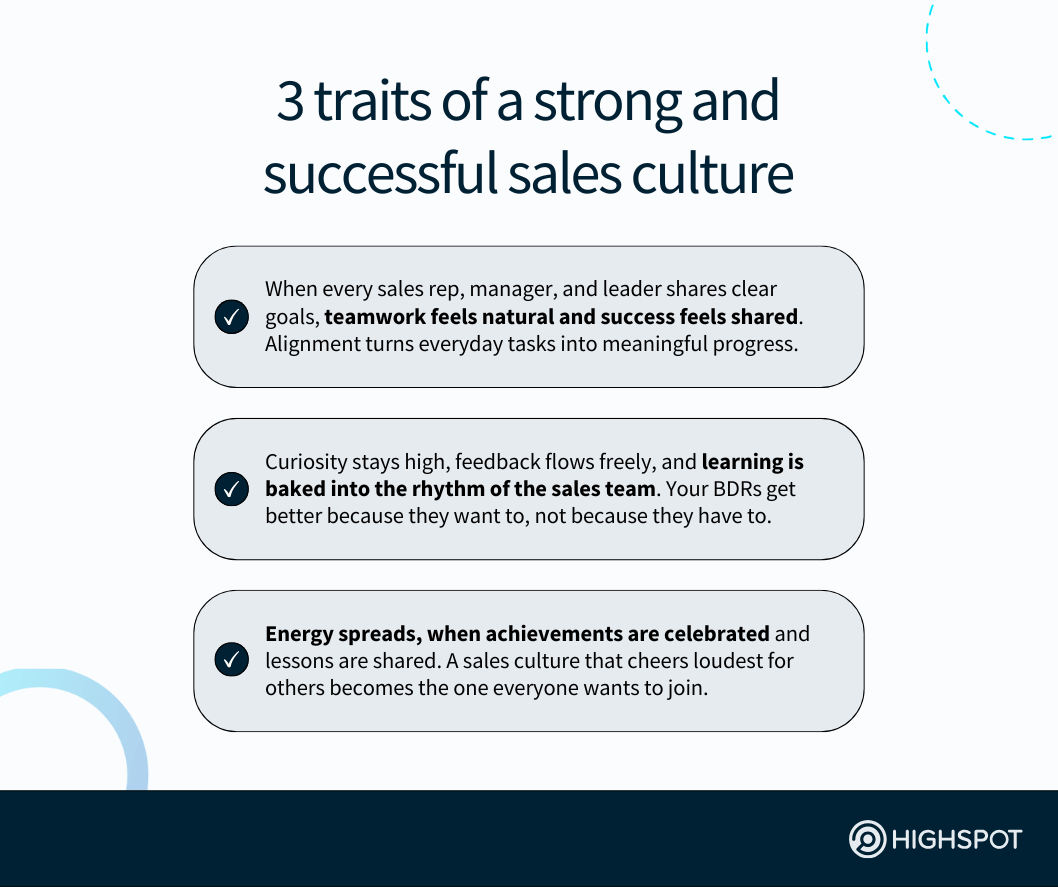Key Takeaways
- A high-performing sales team culture begins with leadership that models shared values, fosters healthy competition, and promotes trust to keep the entire team motivated and aligned.
- Motivation is more than money. The strongest B2B sales teams today strike a balance between fair financial rewards and intrinsic motivators—autonomy, belonging, mastery, and purpose—that sustain employee engagement and growth in a high-performance culture.
- Advanced go-to-market (GTM) technology can regularly reinforce strong sales cultures by connecting strategy to action, aligning team members, and providing sellers, specifically, with clarity to move quickly with purpose.
A strong sales team culture isn’t defined by fancy coffee or free lunches.
Those perks may give the illusion of a good culture—one popularized by early tech startup campuses with ping-pong and nap pods—but they can’t replace purpose and belonging.
Your employees want to contribute to something bigger.
They want to make a difference, grow, and have supportive GTM leaders.
Simply put, a healthy organization’s sales culture starts at the top.
When leadership embodies the company’s purpose, mission, vision, and values every day and helps managers and individual contributors alike progress, rather than guard their own turf, they set the tone for the entire business.

Why a high-performance culture matters for today’s B2B sales teams
In high-performing teams, culture shows up in the everyday behaviors that connect strategy to execution. A winning sales team culture attracts (and retains) top performers and helps them thrive and achieve mobility goals over time.
According to recent Gallup research, employees who strongly agree with the statement “I feel connected to my organization’s culture” are 4.3 times as likely to be engaged at work.
That kind of employee engagement translates into substantially improved sales productivity, better client retention, and stronger customer relationships in the long run.
It’s evident that the benefits of a flourishing sales (and company) culture are many.
Notably, a high-performance culture that leads to routinely high eNPS scores is one that:
Builds a healthy, competitive culture that encourages continual growth
Healthy competition inspires improvement, while toxic rivalry breeds attrition.
Unfortunately, some leaders still mistake rivalry for motivation, pitting sales representatives against one another in ways that lead to internal conflict, make collaboration uncomfortable, and erode trust instead of building it.
To cultivate healthy competition among your sales reps, your managers should:
- Celebrate both team and individual wins. Give every victory its moment in the spotlight, whether it’s a closed deal or a teammate lending a hand. Recognition boosts morale and sparks friendly competition in the best way. When people feel appreciated, they bring more energy, creativity, and drive to the next challenge.
- Reward collaboration and mentorship. Great sales pros lift each other up, so spotlight those who share their playbooks and help others level up. Create peer recognition moments that show mentorship matters just as much as metrics. Over time, this builds trust and transforms competition into shared progress.
- Keep leaderboards transparent but focused on growth metrics. Visibility keeps things honest and inspiring, when it highlights learning and improvement instead of pure rankings. Encourage reps to track personal bests so success feels within reach for everyone. When progress becomes the prize, growth feels exciting, not stressful.
Just remember, though, that—at the end of the day—all reps are working toward the same goals. Competition is ideal, but don’t go too far with pushing BDRs to ‘battle it out.’
“Competitiveness can be both a boon for your company (e.g., the sales will keep coming) and a burden for you (e.g., you’re trying to keep high-achievers from acting aggressively or impulsively),” Entrepreneur Leadership Network® Contributor Peter Daisyme recently wrote.
Balances financial rewards with intrinsic motivation
While in many organizations, sales management instinctively turns to bonuses, time off, or increased compensation, these extrinsic motivators eventually lose their power.
A positive sales culture balances financial incentives, like on-target earnings, with intrinsic motivators, including autonomy, additional sales skills, a sense of belonging, and status.
When reps feel trusted to make decisions, see their progress recognized, and understand how their work impacts customers and the business, motivation becomes self-sustaining. In great sales cultures, achievement is fueled not by pressure, but by pride in meaningful work.
Connects sales performance to customer impact
Look beyond revenue targets and measure how well your team—on both an individual and collective level—delivers value by connecting sales activity to customer outcomes.
When reps understand the why behind their sales goals—how each call, meeting, or proposal contributes to solving real customer challenges—they stay focused on the right outcomes.
Your business development reps will shift from chasing continually increasing sales quota attainment goals to focusing on value-based selling that best serves buyers.
| Traits of a healthy sales culture | Traits of a toxic sales culture |
| Every rep feels aligned around clear North Star goals that guide daily decisions and inspire collective progress. | Teams lack a unifying direction, causing confusion, frustration, and wasted effort across the entire organization. |
| Go-to-market leaders prioritize shared values that foster trust, transparency, and accountability across the sales team | Managers ignore shared values and allow favoritism or unethical behavior to erode team trust and collaboration. |
| The company maintains a high-performing culture where everyone contributes to long-term growth and ongoing customer success. | The organizations struggles to sustain momentum, in terms of team growth, and spends too much time dealing with poor performance or internal drama. |
| Managers promote ongoing training and coaching so reps stay sharp, adaptable, and motivated to improve daily. | Leaders neglect skill development and create stagnation by failing to invest in ongoing training and coaching programs. |
| Enablement ensures reps feels equipped with resources (content, messaging, plays) and support needed to continually enhance the sales team culture. | Sales teams feel unequipped and unprepared to meet demands because enablement efforts are inconsistent, outdated, or poorly communicated. |
| Leaders rewards effort, collaboration, and results equally, proving each contribution is important to organizational success. | Leaders only reward top performers and ignore teamwork, damaging morale and discouraging consistent, shared progress. |
| The sales process is clear, repeatable, and rooted in alignment between teams to drive predictable and scalable results. | Lack of GTM team alignment leads to confusion in the sales process and results in frustration and missed targets. |
| New and experienced reps alike buy in to the company mission because they see fairness, recognition, and opportunity for sustainable quota attainment. | The business is constantly losing salespeople due to burnout, lack of recognition, and no faith in achievable sales quota attainment. |
How to build a sales culture that attracts, retains, and empowers talent
Retention is the clearest sign of a successful business culture.
People stay where they feel they belong. As Forbes Business Council member Aleksandr Zemel wrote, “The strongest sales teams are built on cultural fit as much as skill. I would choose a capable seller who lives our mission statement and values of fairness, resilience, and teamwork over a top biller who does not share them.”
That philosophy reflects what the best organizations already know: When you hire for corporate culture and coach for growth, the benefits, including optimal performance, follow.
Lead with purpose—not just sales pipeline goals
Your sales pipeline is a measurable metric. Purpose is not.
But you can see its impact everywhere across your team.
Purpose unites people behind the “why” of their work and makes day-to-day selling more meaningful. For a sales rep, purpose might look like helping a small business grow, solving a technical challenge, or improving someone’s day-to-day work.
When leaders regularly share real stories about how their product or service made a difference, it reminds sellers that every deal represents progress for the customer, not just revenue for the company.
You’ll know your team has found purpose when their motivation feels less about “hitting the number” and more about helping customers succeed. That shift builds pride, loyalty, and trust that no incentive plan can replace.
When sellers lose sight of that purpose, culture and performance quickly erode.
Define what good looks like, then model it
Sales managers can prevent reps from guessing what success looks like by clearly defining what “good” means through consistent expectations, processes, and examples.
For example, a sales leader who regularly shares detailed win stories that break down how discovery went, what questions uncovered customer pains, and how objections were resolved, actually create performance playbooks in real time.
Tie sales training to real-world sales outcomes
Training only matters if it changes results. As McKinsey & Co. analysts recently wrote, “Sales organizations need to revamp their hiring practices, repurpose training, and retool coaching and mentoring to support hybrid and remote reps.”
It’s easy to forget those who work out of sight, but they have just as much impact on results as those in the office. The best sales training programs today embed learning into daily routines and make it accessible anywhere.
Real-world feedback, just-in-time coaching, and a little time for reflection fill sales training with small learning loops that are visible, relevant, and ongoing.
Build sales onboarding that shortens ramp time
The first few months determine whether new hires have what it takes (and if you have what they need), but culture starts before day one.
During the recruitment process, ask candidates about their work style, how they collaborate, and what they value in a team. These early conversations can reveal major red flags that signal a potential mismatch with your culture.
Strong onboarding programs connect company culture and process from the start.
Pair new hires with mentors. Expose them to customer challenges early. Reinforce core values so they know exactly what the business stands for and how they’ll contribute.
Coach consistently, not just when there’s time
When managers only coach reactively around quarterly reviews or sales kickoff meetings, performance tends to plateau. Those stressful, infrequent sales development sessions can feel overwhelming and backward-looking.
Consistent coaching offered on a weekly or bi-weekly rhythm, on the other hand, feels more natural and builds knowledge sharing habits, trust, and alignment.
Even using standardized frameworks, such as the MEDDIC sales methodology for qualifying leads, provides a shared language and a common lens for identifying gaps and opportunities.
See how consistent coaching drives sales excellence.
Keep your sales team relentlessly customer-centric
Customer centricity keeps teams focused on providing solutions with value, not volume.
The best, culturally aligned sellers see themselves as problem solvers, not product pushers. Encourage reps to ask, “What outcome does this customer need to achieve today?”
That mindset shift changes the tone of every conversation and turns selling into service.
Adopt an agile philosophy to adapt to shifting buyers and markets
High-performing cultures test, learn, and adapt quickly to change, such as shifting buyer behaviors, new pricing models, competitors, or customer expectations.
Instead of relying on scripts, they experiment with new approaches, share what works (and what doesn’t), and adjust in real time. The openness to iteration builds the resilience and adaptability that is expected of a thriving company’s sales culture.
GTM technology’s critical role in creating a high-performance sales culture
A strong sales culture cannot be bought in a tool, but modern go-to-market (GTM) systems are the very things that make a strong culture work.
Integrated, data-driven tools provide leaders with a clear view of what’s working and sellers with the clarity they need in the flow of their daily work.
For example, use sales dashboards with real-time, up-to-date analytics to connect individual and team goals to customer outcomes or link coaching feedback directly with call recordings. This reinforces future desired winning behaviors.
Today’s leaders (along with those in marketing and enablement) “are expected to deliver precision, scale, and impact, often with less time, tighter resources, and higher expectations,” according to Highspot’s GTM Performance Gap Report.
However, as our go-to-market study also noted, “That level of performance doesn’t come from adding more tools or relying on AI for sales to do the heavy lifting. It comes from building systems that connect strategy to action, align every team around a shared goal, and give sellers the clarity to move fast with purpose.”
The right GTM technology serves as the connective tissue.
It links performance data, content, coaching, and collaboration, so culture doesn’t fade even with distributed teams and rapid growth. When tech mirrors culture—transparent, connected, data-informed—it becomes the framework that scales it.
Building a strong sales culture that lasts—and leads to revenue growth
A good sales culture is foundational to every successful company.
In fact, it’s what keeps your sales force focused, reps motivated, and team cohesion strong, even as customers evolve, markets shift, and business goals change or emerge.
For go-to-market leaders such as yourself, the real work lies in understanding culture and translating purpose into daily behaviors through consistent day-to-day selling processes, clear sales performance management, and using AI-powered GTM platforms that reinforce good habits, open communication, and encourage collaboration.
When B2B organizations like yours invest in a thriving sales culture through sales development efforts, they see improvements in employee satisfaction and their dedication to new business development—they want to share the company value with others.
Build the kind of successful sales culture that attracts and retains top talent, and you won’t need to push monetary incentives on your team that ultimately fall short.
With an enviable culture in place, your sellers will push themselves—driven by purpose, pride, and a shared vision that connects everyone to the organization’s goals.




